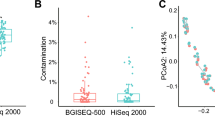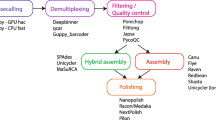Abstract
The generation of genomic data from microorganisms has revolutionized our abilities to understand their biology, but it is still challenging to obtain complete genome sequences of microbes in an automated high-throughput and cost-effective manner. While the advent of second-generation sequencing technologies provided significantly higher throughput, their shorter lengths and more pronounced sequence-context bias led to a shift towards resequencing applications. Recently, single molecule real-time (SMRT) DNA sequencing has been used to generate sequencing reads that are much longer than other sequencing platforms, facilitating de novo genome assembly and genome finishing. Here we introduced a novel multiplex strategy to make full use of the capacity and characteristics of SMRT sequencing in microbe genome assembly. We used error-free simulations to evaluate the practicability of assembling SMRT genomic sequencing data from multiple microbes into finished genomes once at a time. Then we compared the influence of two key factors, including sequencing coverage and read length, on multiplex assembling. Our results showed that long-read genomic sequencing inherently provided the ability to assemble genomic sequencing data from multiple microbes into finished genomes due to its long length. This approach might be helpful for the various groups of microbial genome projects or metagenomics research.




Similar content being viewed by others
References
Fraser CM, Eisen JA, Nelson KE, Paulsen IT, Salzberg SL (2002) The value of complete microbial genome sequencing (you get what you pay for). J Bacteriol 184(23):6403–6405
Medini D, Serruto D, Parkhill J, Relman DA, Donati C, Moxon R, Falkow S, Rappuoli R (2008) Microbiology in the post-genomic era. Nat Rev Microbiol 6:419–430
Gagarinova A, Emili A (2012) Genome-scale genetic manipulation methods for exploring bacterial molecular biology. Mol Biosyst 8:1626–1638
Loman NJ, Constantinidou C, Chan JZ, Halachev M, Sergeant M, Penn CW, Robinson ER, Pallen MJ (2012) High-throughput bacterial genome sequencing: an embarrassment of choice, a world of opportunity. Nat Rev Microbiol 10:599–606
Korlach J (2014) Returning to more finished genomes. Genome Data 2:46–48
Parkhill J, Wren BW (2011) Bacterial epidemiology and biology—lessons from genome sequencing. Genome Biol 12:230
Nagarajan N, Cook C, Di Bonaventura M, Ge H, Richards A, Bishop-Lilly KA, DeSalle R, Read TD, Pop M (2010) Finishing genomes with limited resources: lessons from an ensemble of microbial genomes. BMC Genomics 11:242
Chain PS, Grafham DV, Fulton RS, Fitzgerald MG, Hostetler J, Muzny D, Ali J, Birren B, Bruce DC, Buhay C, Cole JR, Ding Y, Dugan S, Field D, Garrity GM, Gibbs R, Graves T, Han CS, Harrison SH, Highlander S, Hugenholtz P, Khouri HM, Kodira CD, Kolker E, Kyrpides NC, Lang D, Lapidus A, Malfatti SA, Markowitz V, Metha T, Nelson KE, Parkhill J, Pitluck S, Qin X, Read TD, Schmutz J, Sozhamannan S, Sterk P, Strausberg RL, Sutton G, Thomson NR, Tiedje JM, Weinstock G, Wollam A, Genomic Standards Consortium Human Microbiome Project Jumpstart Consortium, Detter JC (2009) Genome project standards in a new era of sequencing. Science 326(5950):236–237
Ricker N, Qian H, Fulthorpe RR (2012) The limitations of draft assemblies for understanding prokaryotic adaptation and evolution. Genomics 100:167–175
Harrison J, Studholme DJ (2014) Recently published Streptomyces genome sequences. Microb Biotechnol 7(5):373–380
Mardis ER (2013) Next-generation sequencing platforms. Annu Rev Anal Chem 6:287–303
Roberts RJ, Carneiro MO, Schatz MC (2013) The advantages of SMRT sequencing. Genome Biol 14(7):405
Koren S, Phillippy AM (2015) One chromosome, one contig: complete microbial genomes from long-read sequencing and assembly comparisons. Curr Opin Microbiol 23:110–120
Ribeiro FJ, Przybylski D, Yin S, Sharpe T, Gnerre S, Abouelleil A, Berlin AM, Montmayeur A, Shea TP, Walker BJ, Young SK, Russ C, Nusbaum C, MacCallum I, Jaffe DB (2012) Finished bacterial genomes from shotgun sequence data. Genome Res 22:2270–2277
Koren S, Schatz MC, Walenz BP, Martin J, Howard JT, Ganapathy G, Wang Z, Rasko DA, McCombie WR, Jarvis ED, Phillippy AM (2012) Hybrid error correction and de novo assembly of single-molecule sequencing reads. Nat Biotechnol 30:693–700
Bashir A, Klammer AA, Robins WP, Chin CS, Webster D, Paxinos E, Hsu D, Ashby M, Wang S, Peluso P, Sebra R, Sorenson J, Bullard J, Yen J, Valdovino M, Mollova E, Luong K, Lin S, LaMay B, Joshi A, Rowe L, Frace M, Tarr CL, Turnsek M, Davis BM, Kasarskis A, Mekalanos JJ, Waldor MK, Schadt EE (2012) A hybrid approach for the automated finishing of bacterial genomes. Nat Biotechnol 30:701–707
Prjibelski AD, Vasilinetc I, Bankevich A, Gurevich A, Krivosheeva T, Nurk S, Pham S, Korobeynikov A, Lapidus A, Pevzner PA (2014) ExSPAnder: a universal repeat resolver for DNA fragment assembly. Bioinformatics 30(12):i293–301
Boetzer M, Pirovano W (2014) SSPACE-LongRead: scaffolding bacterial draft genomes using long read sequence information. BMC Bioinform 15:211
Chin CS, Alexander DH, Marks P, Klammer AA, Drake J, Heiner C, Clum A, Copeland A, Huddleston J, Eichler EE, Turner SW, Korlach J (2013) Nonhybrid, finished microbial genome assemblies from long-read smrtsequencing data. Nat Methods 10(6):563–569
Koren S, Harhay GP, Smith TP, Bono JL, Harhay DM, Mcvey SD, Radune D, Bergman NH, Phillippy AM (2013) Reducing assembly complexity of microbial genomes with single-molecule sequencing. Genome Biol 14(9):R101
Lin HH, Liao YC (2015) Evaluation and validation of assembling corrected PacBio long reads for microbial genome completion via hybrid approaches. PLoS ONE 10(12):e0144305
Sohn JI, Nam JW (2016) The present and future of de novo whole-genome assembly. Brief Bioinform 19:23–40
Liao YC, Lin SH, Lin HH (2015) Completing bacterial genome assemblies: strategy and performance. Sci Rep 5:8747
Wong KH, Jin Y, Moqtaderi Z (2013) Multiplex illumina sequencing using DNA barcoding. Curr Protoc Mol Biol 101(7):11
Lam KK, Khalak A, Tse D (2014) Near-optimal assembly for shotgun sequencing with noisy reads. BMC Bioinform 15(9):S4
Salmela L, Walve R, Rivals E, Ukkonen E (2016) Accurate self-correction of errors in long reads using de Bruijn graphs. Bioinformatics 33:799–806
Wenger AM, Peluso P, Rowell WJ, Chang PC, Hall RJ, Concepcion GT, Ebler J, Fungtammasan A, Kolesnikov A, Olson ND, Töpfer A, Alonge M, Mahmoud M, Qian Y, Chin CS, Phillippy AM, Schatz MC, Myers G, DePristo MA, Ruan J, Marschall T, Sedlazeck FJ, Zook JM, Li H, Koren S, Carroll A, Rank DR, Hunkapiller MW. 2019. Accurate circular consensus long-read sequencing improves variant detection and assembly of a human genome. Nat Biotechnol. 1–8
Barbe V, Cruveiller S, Kunst F, Lenoble P, Meurice G, Sekowska A, Vallenet D, Wang T, Moszer I, Médigue C, Danchin A (2009) From a consortium sequence to a unified sequence: the Bacillus subtilis 168 reference genome a decade later. Microbiology 155(Pt 6):1758–1775
Rhee MS, Moritz BE, Xie G, Glavina Del Rio T, Dalin E, Tice H, Bruce D, Goodwin L, Chertkov O, Brettin T, Han C, Detter C, Pitluck S, Land ML, Patel M, Ou M, Harbrucker R, Ingram LO, Shanmugam KT (2011) Complete genome sequence of a thermotolerant sporogenic lactic acid bacterium, Bacillus coagulans strain 36D1. Stand Genomic Sci 5(3):331–340
Djukic M, Poehlein A, Thürmer A, Daniel R (2011) Genome sequence of Brevibacillus laterosporus LMG 15441, a pathogen of invertebrates. J Bacteriol 193(19):5535–5536
Johnson M, Zaretskaya I, Raytselis Y, Merezhuk Y, McGinnis S, Madden TL (2008) NCBI BLAST: a better web interface. Nucleic Acids Res 36:W5–9
Acknowledgements
This work is supported by Teachers' Research Start-up Fund from Changshu Institute of Technology (KYZ2018009Q), the Natural Science Foundation of Jiangsu Province (BK20181034). The fundings have no role in the design of the study and collection, analysis, and interpretation of data and writing the manuscript.
Author information
Authors and Affiliations
Corresponding author
Ethics declarations
Conflict of interest
The authors declare that they have no conflict of interest.
Additional information
Publisher's Note
Springer Nature remains neutral with regard to jurisdictional claims in published maps and institutional affiliations.
Rights and permissions
About this article
Cite this article
Qian, J., Meng, Q., Feng, Y. et al. Multiplexed Non-barcoded Long-Read Sequencing and Assembling Genomes of Bacillus Strains in Error-Free Simulations. Curr Microbiol 77, 79–84 (2020). https://doi.org/10.1007/s00284-019-01808-3
Received:
Accepted:
Published:
Issue Date:
DOI: https://doi.org/10.1007/s00284-019-01808-3




